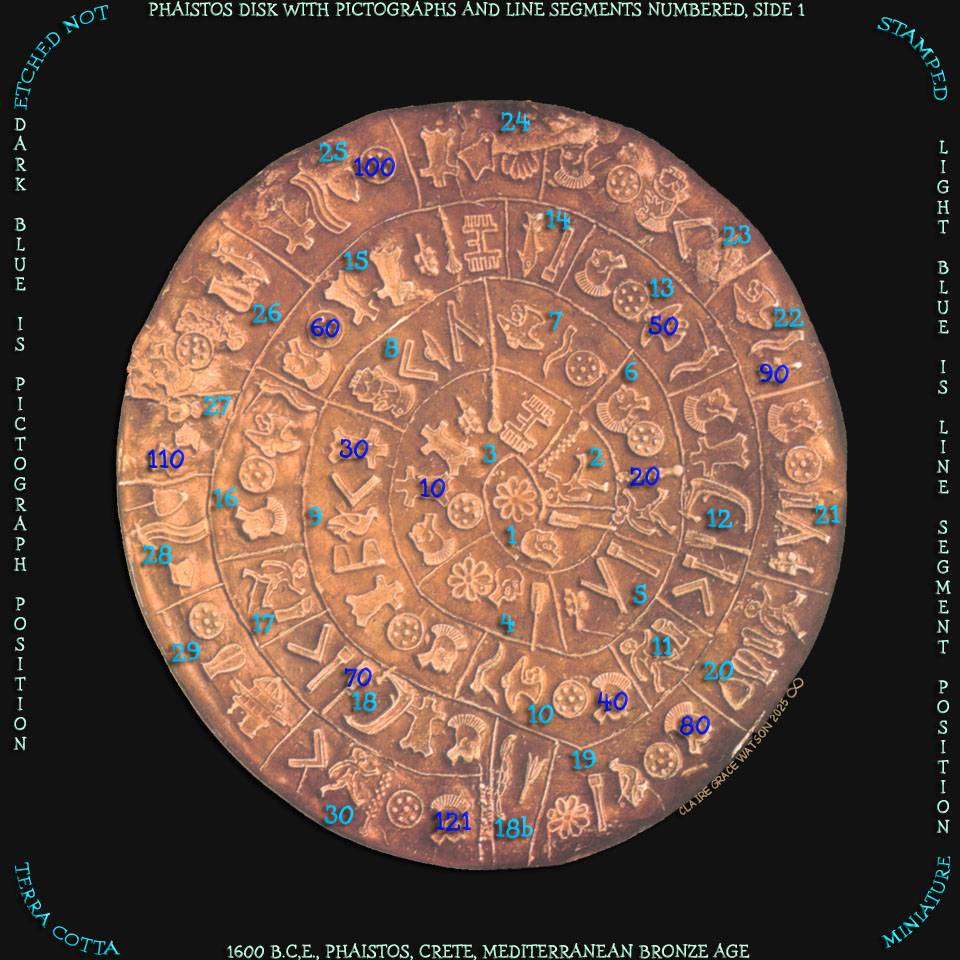 | 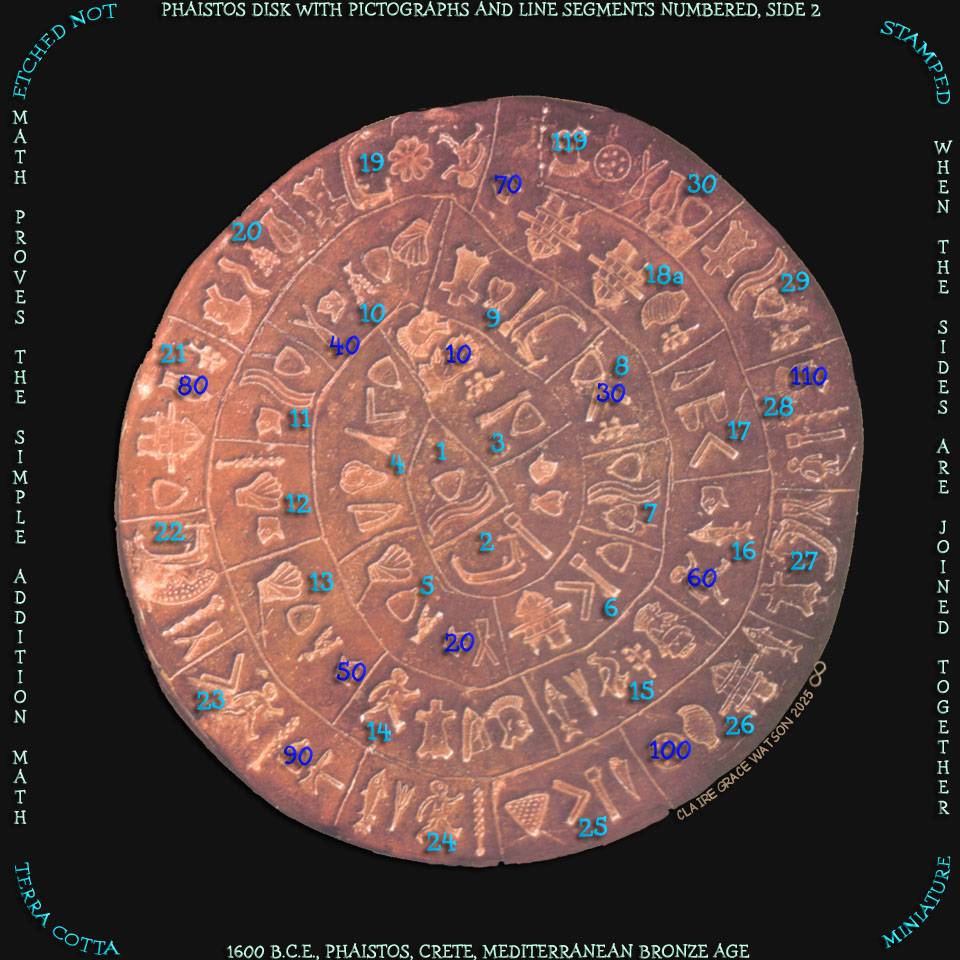 |
The pictographs below are exact tracings by me of the pictographs on the Phaistos Disk. Apparently, I am the only person to ever go to the trouble to do this. Before I began working on the disk I traced each pictograph because the only other pictograph images I could find were Sir Arthur Evans' freehand drawings of the pictographs, which obviously he did in a hurry. But Evans did not have the advantage of a copy machine as I did, nor did the artist of the Disk who etched each one individually into the Disk before the clay dried.
I duplicated each pictograph tracing times the number of times it appears on the Phaistos Disk and then I taped each one onto my tracing of the disk spirals, to pinpoint their exact locations. Because each repeated pictograph on the Phaistos Disk was intended to appear exactly identical, the only way to exactly duplicate the disk is by using a copy machine to duplicate each pictograph. I include Evans' pictograph drawings to the left of each one that I traced.
These are pictographs, not hieroglyphs. Sir Arthur Evans makes the case for Cretan pictographs in his book Cretan Pictographs and Prae-Phoenician Script. I would add that I think many of the pictographs, if not all of them, are graphical abbreviations for the constellations (Arktypes, Ships/Arks of the Sky).
Position = location of the sign on the disk; Segment = the line segment in which the sign occurs. Both are relative to the center of the disk spiraling out. A = Side 1, B = Side 2. Geometry = created by sign(s)

Sun/Flower, Helios, Eight, Vertex
3 Side A, Positions - 1, 13, 76; Segments - 1, 4, 19; Geometry - Scalene Triangle
1 Side B, Position - 72; Segment - B19; Geometry - Geometric Point
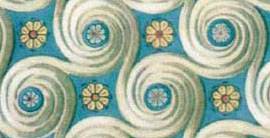
Similar to this 8-petal flower is center the wave spirals on a Minoan ceiling, and the Queen's Bathroom, Palace at Knossos and (below) 8-petal Flower of Life guarded by god Horus (death) and goddess Mut (life) on Egyptian limestone relief (with Disk pictograph Falcon/Hawk on the perch)
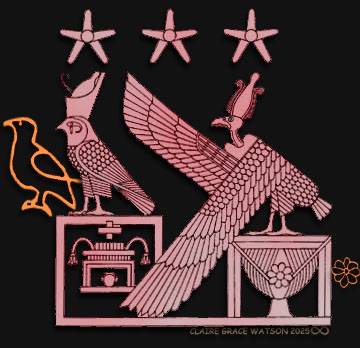

Sailor with Rope Truss tattoo, Argonaut, Minyae, Divine Curete, Maze Puzzle Clue
2 Side A, Positions - 2, 14; Segments - 1, 4; Geometry - Straight Line

Oar, Argonauts, Minyae, Minyaens
4 Side A, Positions - 3, 15, 45, 70; Segments - 1, 4, 12, 18; Geometry - Quadrilateral
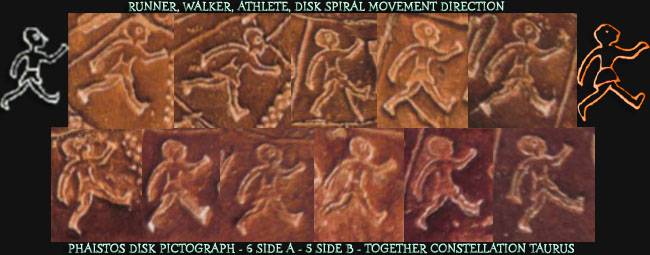
Evans gave his runner a little something extra
Runner, Walker, Athlete
Constellation Taurus, all connected, both sides
6 Side A, Positions - 4, 19, 41, 66, 84, 118; Segments - 2, 6, 11, 17, 20, 30; Geometry - Polygon
5 Side B, Position - 51, 60, 71, 88, 94; Segments - 14, 16, 19, 23, 24; Geometry - Polygon
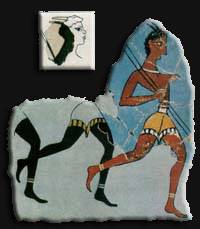

Evans really modified this pictograph. Spindle, phallas of Osiris chewed by Sharpsnout Fish
3 Side A, Position - 5, 20, 119; Segments - 2, 6, 30; Geometry - Acute Triangle
3 Side B, Position - 44, 89, 95; Segments - 12, 23, 24; Geometry - Isosceles Triangle

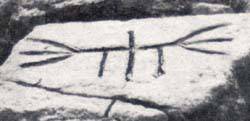
Maze, Palace, Ziggurat symbol meaning House of the God, Three, Ja
2 Side A, Positions - 6, 55; Segments - 3, 15; Geometry - Straight Line

Evans thought this pictograph is Papyrus. Thistle, Thyrsoi, Thyrsuses Festival Wand carried in the Festival of Dionysis, Papyrus
2 Side A, Positions - 7, 56; Segments - 3, 15; Geometry - Diameter
2 Side B, Position - 85, 109 Segments - 22, 28; Geometry - Straight Line
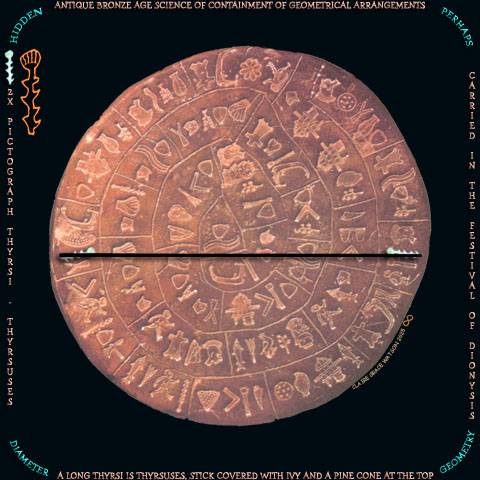
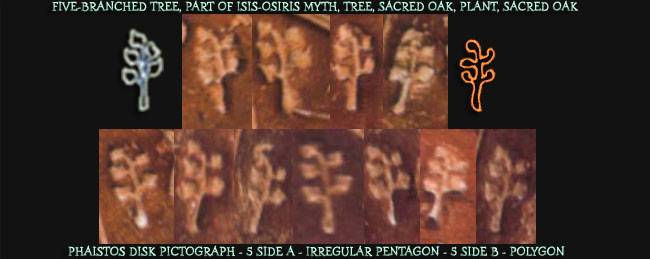
Five-Branched Tree, a part of Isis-Osiris myth, Tree, Sacred Oak, Plant
5 Side A, Positions - 8, 16, 57, 85, 90; Segments - 3, 5, 15, 21, 22; Geometry - Irregular Pentagon
6 Side B, Positions - 9, 29, 58, 66, 79, 111, Segments - 3, 8, 15, 18, 21, 29; Geometry - Polygon
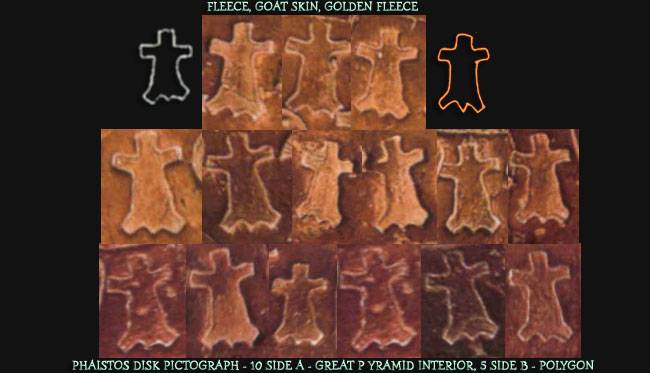
Fleece, Goat skin, Golden Fleece
10 Side A, Positions - 9, 10, 30, 34, 47, 58, 59, 72, 99, 103; Segments - 3, 3, 9, 9, 12, 15, 15, 19, 24, 25; Geometry - Great Pyramid Interior
5 Side B, Positions - 35, 52, 74, 104, 114; Segments - 9, 14, 19, 27, 29; Geometry - Polygon
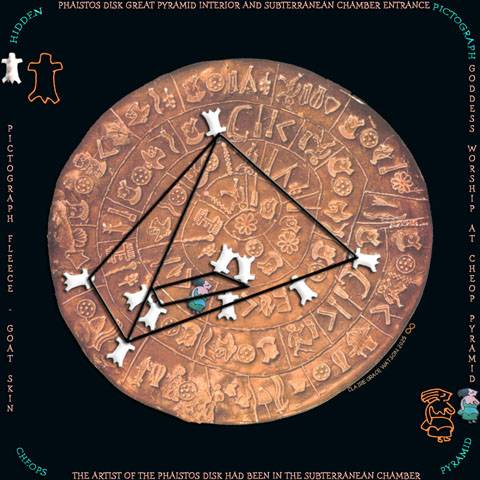
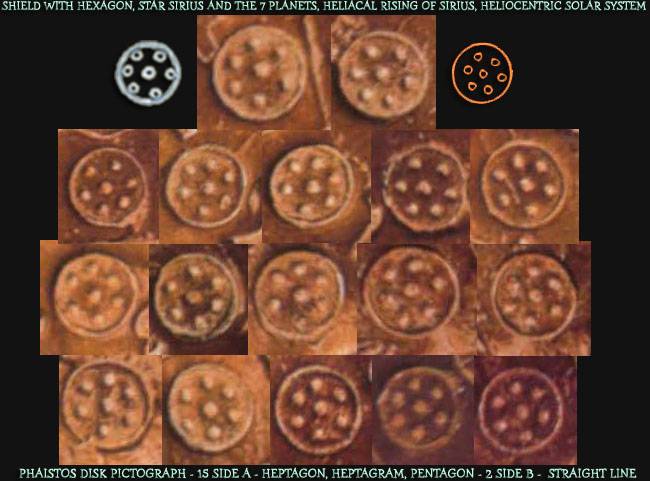
Evans did not copy the shield in the hexagonal pattern. Shield with Hexagon, Star Sirius and the 7 Planets, Heliacal Rising of Sirius, Pentagram, Heptagram, Heptagon, Bronze Shield, Hexagram, Hexahedron
15 Side A, Positions - 11, 21, 23, 35, 39, 51, 60, 64, 79, 88, 95, 100, 107, 114, 120;
Segments - 3, 6, 7, 9, 10, 13, 15, 16, 19, 21, 23, 25, 26, 29, 30; Geometry - Heptagon, Heptagram, Pentagon
2 Side B, Positions - 100, 118; Segments - 26, 30; Geometry - Straight Line
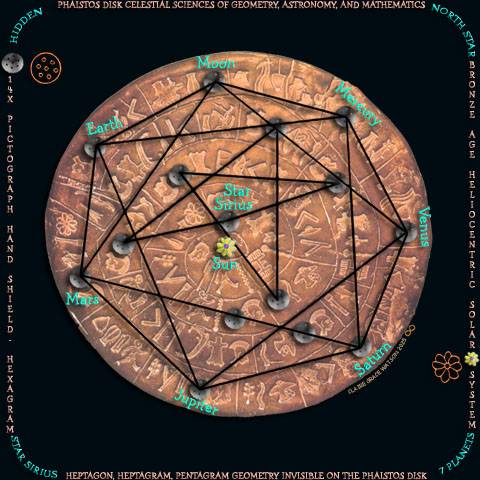
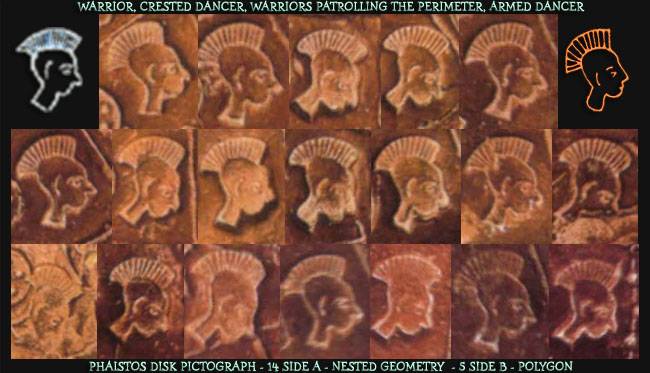
Warrior, Crested Dancer, Cave of Zeus, Warriors Patrolling the Perimeter, Minyae, Armed Dancer
14 Side A, Positions - 12, 22, 36, 40, 48, 52, 61, 65, 73, 80, 89, 96, 107, 121;
Segments - 3, 6, 9, 10, 12, 13, 15, 16, 18, 19, 21, 23, 26, 30; Geometry - Nested Geometry
5 Side B, Positions - 11, 54, 78, 110, 119; Segments - 3, 14, 20, 28, 30; Geometry - Polygon
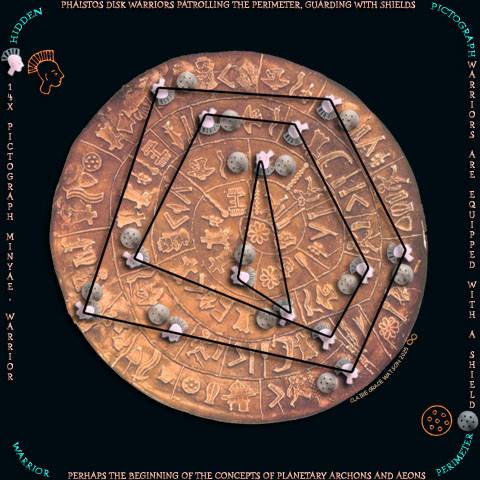

Evans may have seen this as the intersection of a road. Adjacent Angle, Carpenter's Tool, Crossroad, Paved Road
3 Side A, Positions - 17, 26, 86; Segments - 5, 8, 21; Geometry - Obtuse Triangle

Pillar, Tool, Awl, Telescope, Hammer, Carpentry, Leatherworking
5 Side A, Positions - 18, 44, 53, 69, 77; Segments - 5, 12, 14, 18, 19; Geometry - Quadrilateral
4 Side B, Positions - 4, 24, 98, 108; Segments - 2, 6, 25, 26; Geometry - Obtuse Triangle

Horn, Serpent, Fire, Constellation Capricorn
5 Side A, Positions - 24, 37, 49, 62, 91; Segments - 7, 10, 13, 16, 22; Geometry - Quadrilateral
1 Side B, Position - 77; Segment - 20; Geometry - Geometric Point
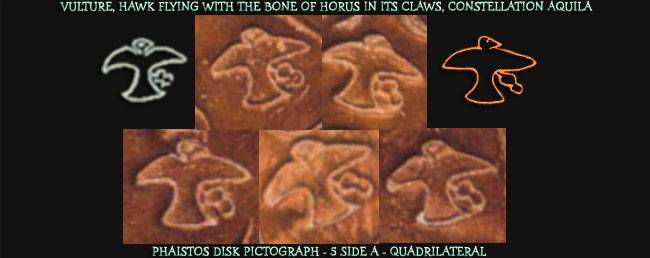
Vulture, Hawk Flying with the Bone of Horus in its Claws, Constellation Aquila
5 Side A, Positions - 25, 38, 50, 63, 92; Segments - 7, 10, 13, 16, 22; Geometry - Quadrilateral

Did Evans think this is a UFO? Hat, UFO
1 Side A, Position - 27; Segment - 8; Geometry - Geometric Point
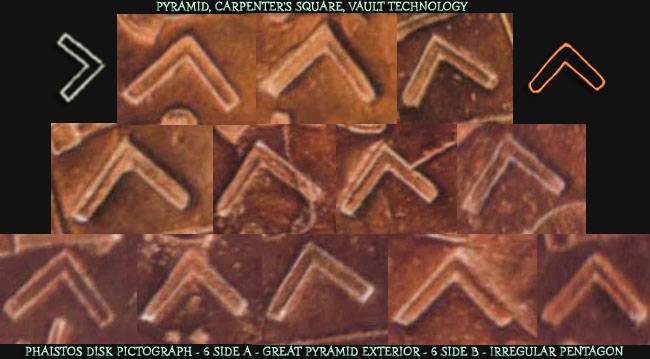
Evans may have used a straight edge to draw this pictograph. Pyramid, Carpenter's Square, Vault Technology
6 Side A, Positions - 28, 31, 43, 68, 93, 117; Segments - 8, 9, 12, 18, 23, 30; Geometry - Great Pyramid Exterior
6 Side B, Positions - 13, 23, 30, 63, 87, 97; Segments - 4, 6, 8, 17, 23, 25; Geometry - Irregular Pentagon
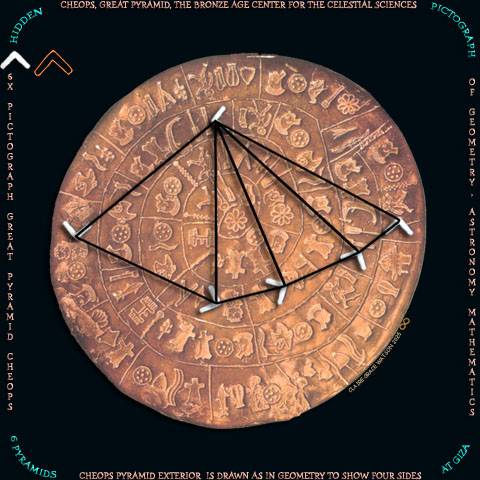

Nurse, Goddess Rhea, Isis Nursing Diktys, Mother
2 Side A, Positions - 29, 94; Segments - 8, 23; Geometry - Straight Line
2 Side B, Positions - 10, 59; Segments - 3, 15; Geometry - Straight Line, Together Rhea's Veil
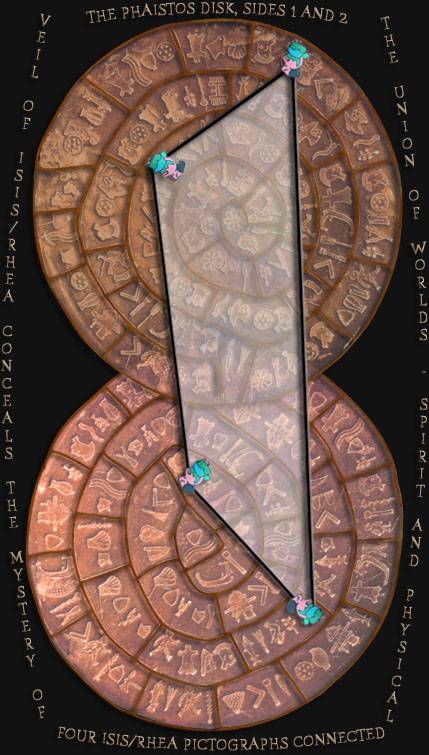

Falcon on the Perch, Bird, Partridge, Dove, Horus
2 Side A, Positions - 32, 78; Segments - 9, 19; Geometry - Straight Line
1 Side B, Position - 57; Segment - 15; Geometry - Geometric Point

Yoke, Primitive Astronomy Glasses, Binoculars
1 Side A, Position - 33; Segment - 9; Geometry - Geometric Point
1 Side B, Position - 64; Segment - 17; Geometry - Geometric Point

Evans perhaps saw it as a bull's foot but drew it facing the opposite way. Hoof, Bull's Foot, Minotaur, the God with the Bull's Foot, Osiris, Constellation Taurus
2 Side A, Positions - 42, 67; Segments - 11, 17; Geometry - Straight Line
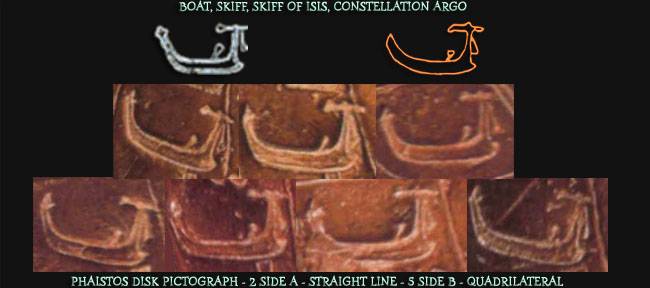
Boat, Skiff, Skiff of Isis, Constellation Argo
2 Side A, Positions - 46, 71; Segments - 12, 18; Geometry - Straight Line
5 Side B, Positions - 3, 32, 73, 83, 105; Segments - 2, 9, 19, 22, 27; Geometry - Quadrilateral
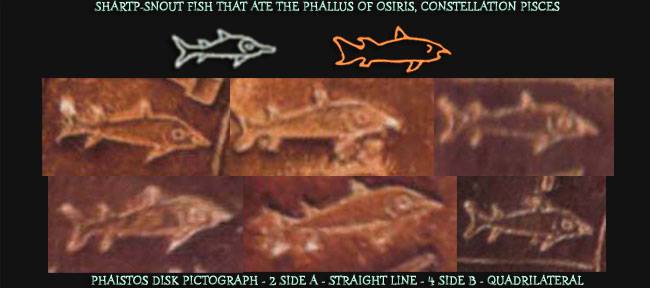
Evans drew this as a Sawfish. Sharp-Snout Fish that ate the phallus of Osiris, Constellation Pisces
2 Side A, Positions - 54, 104; Segments - 14, 26; Geometry - Straight Line
4 Side B, Positions - 55, 61, 92, 103; Segments - 15, 16, 24, 26; Geometry - Quadrilateral

Evans apparently identified this pictograph as a bow. Crab, Nile Crab that ate the phallus of Osiris, Constellation Cancer
1 Side A, Position - 74; Segment - 18; Geometry - Geometric Point

Evans modified this pictograph to a type of trident. Grass, Marsh
1 Side A, Position - 75; Segment - 18; Geometry - Geometric Point
3 Side B, Position - 14, 56, 93; Segment - 4, 15, 24; Geometry - Scalene Triangle
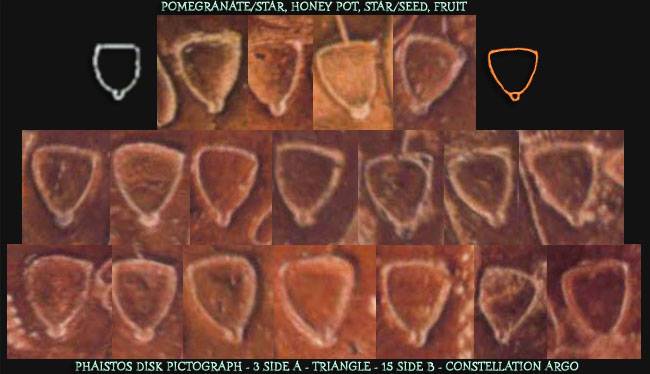
Evans perhaps saw this pictograph as a woman's breast. Pomegranate/Star, Honey Pot, Star/Seed, Fruit
3 Side A, Positions - 871, 101, 111; Segments - 20, 25, 28; Geometry - Triangle
15 Side B, Positions - 1, 7, 12, 18, 25, 26, 28, 31, 37, 41, 48, 82, 90, 112, 115;
Segments - 1, 3, 4, 5, 6, 7, 7, 8, 10, 11, 13, 21, 23, 29, 30; Geometry - Constellation Argo
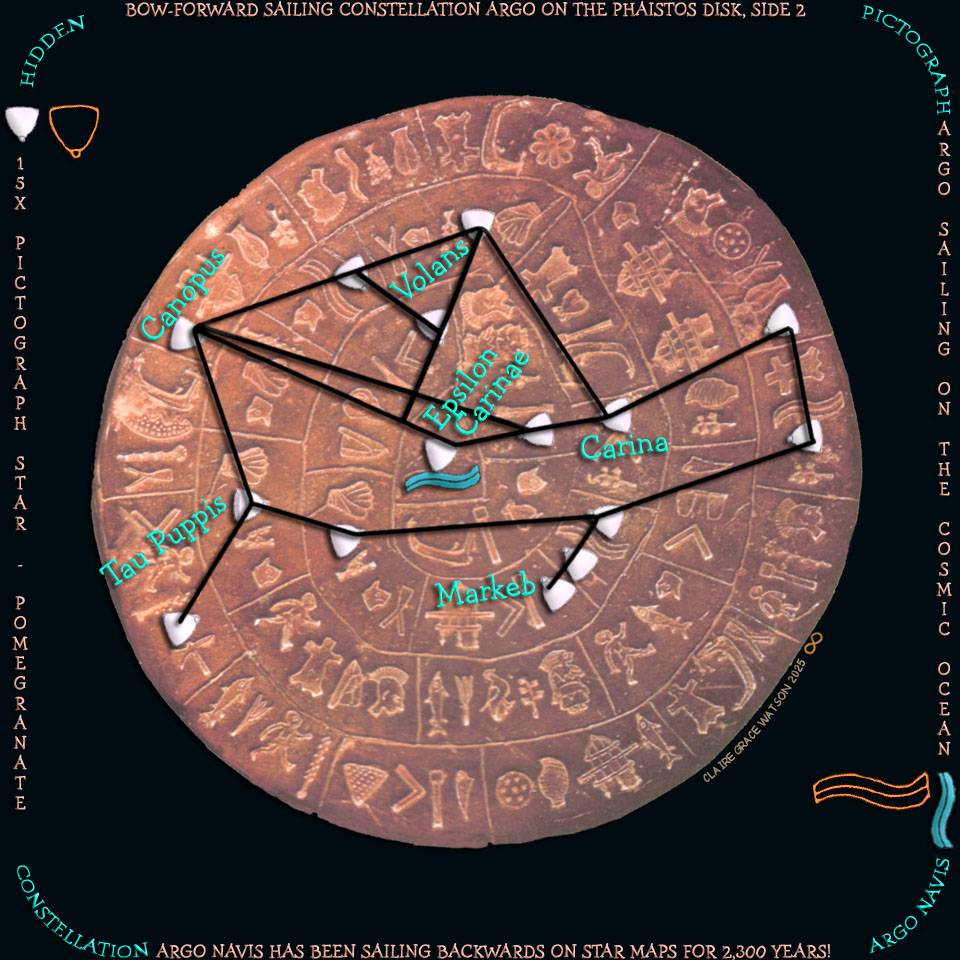

Egyptian Coffin Chest, Casket, Wings of Icarus
3 Side A, Position - 82, 105, 115; Segment - 20, 26, 29; Geometry - Right Triangle
3 Side B, Positions - 75, 80, 116; Segments - 20, 21, 30; Geometry - Obtuse Triangle
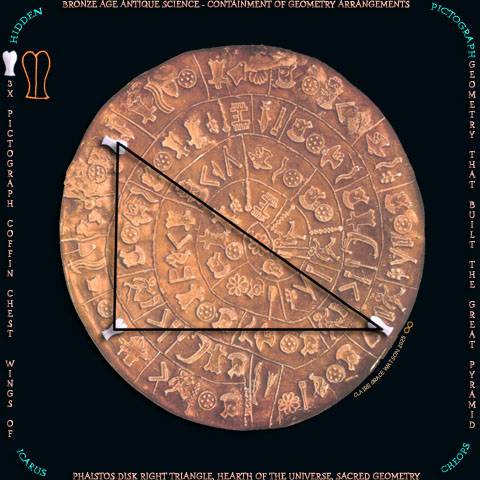

Roll Up, Baby, Rock wrapped as a Baby, Amphora
2 Side A, Positions - 81, 85; Segments - 20, 21; Geometry - Straight Line

Hand Wrap, Glove, Dactyloi (Five Fingers = Cretan), Fingers, Dactyls, 5 Divine Curetes, Hand
1 Side A, Position - 97; Segment - 24; Geometry - Geometric Point
4 Side B, Positions - 17, 36, 45, 47; Segments - 5, 10, 12, 13; Geometry - Cone

Stylized Pig, Typhon's Pig
1 Side A, Position - 98; Segment - 24; Geometry - Geometric Point
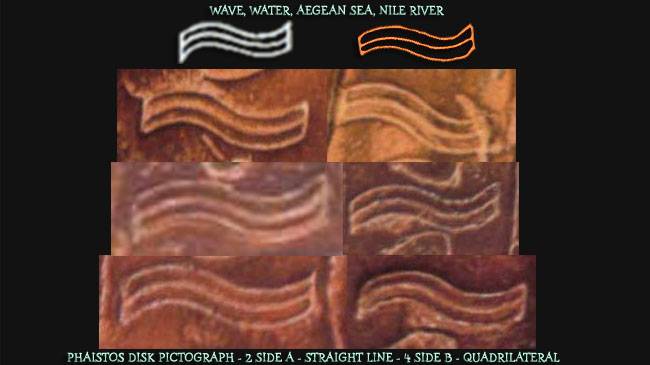
Wave, Water, Aegean Sea, Nile River
2 Side A, Positions - 102, 112; Segments - 25, 28; Geometry - Straight Line
4 Side B, Positions - 2, 27, 42, 113; Segments - 1, 7, 11, 29; Geometry - Quadrilateral

Evans removed the shield this warrior is holding and portrayed him as a captive instead. Warrior, Dactyloi, Father, Orion with the Pleiades hanging from the belt, Ares, Planet Mars
1 Side A, Position - 106; Segment - 26; Geometry - Geometric Point

Evans omitted this pictograph.Dog Scratching, Big Dog - Constellation Canis Major
1 Side A, Position - 108; Segment - 27; Geometry - Geometric Point
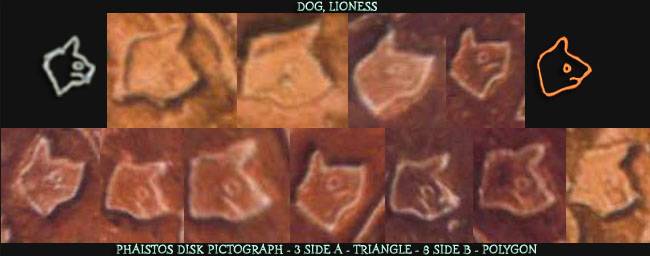
Dog, Lioness
3 Side A, Positions - 109, 110, 113; Segments - 27, 27, 28; Geometry - Triangle
8 Side B, Positions - 6, 20, 39, 43, 46, 50, 62, 70; Segments - 2, 5, 10, 11, 12, 13, 16, 18; Geometry - Polygon
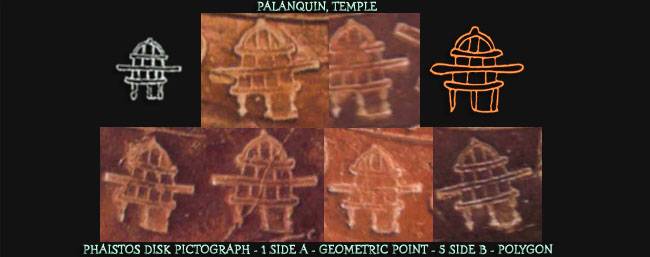
Evans gave the second level four sections instead of three. Palanquin, Temple
1 Side A, Position - 116; Segment - 29; Geometry - Geometric Point
5 Side B, Positions - 22, 68, 69, 81, 102; Segments - 6, 18, 18, 21, 26; Geometry - Polygon

Evans seemed to think this pictograph is a bug. Ant, Bug, Ivy, Heart of Dionysis
2 Side B, Positions - 5, 34; Segments - 2, 9; Geometry - Straight Line

Evans omitted this pictograph. Hoe, Tool, Sweep of Osiris, Scepter
2 Side B, Positions - 8, 33; Segments - 3, 9; Geometry - Geometric Point

Evans gave the ram an ear and omitted the nose. Ram, Constellation Aries
1 Side B, Position - 15; Segment - 4; Geometry - Geometric Point

Sacred Cave Entrance, Hoodwink of a Priest's Robe, Initiate, Mystery
2 Side B, Positions - 16, 53; Segments - 4, 14; Geometry - Geometric Point

Evans saw this pictograph as an olive branch. Plant, Grass, Olive Branch
4 Side B, Positions - 19, 38, 49, 76; Segments - 5, 10, 13, 20; Geometry - Rectangle

Tool, Gauge, Measuring Device, Fork
5 Side B, Positions - 21, 40, 86, 106, 117; Segments - 5, 10, 22, 27, 30; Geometry - Great Pyramid, Apex, Base, Two Sides
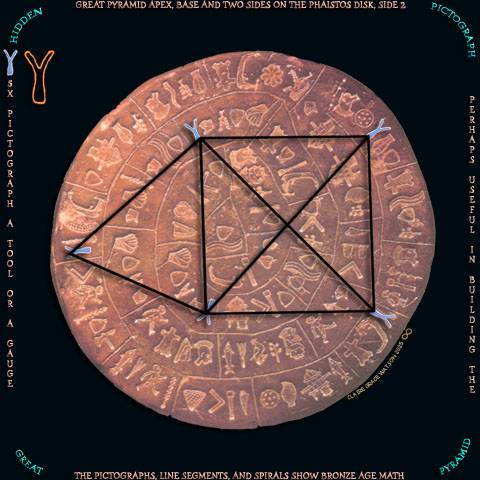

Shell, Trumpet, Festival of Dionysis
2 Side B, Positions - 65, 99; Segments - 17, 25; Geometry - Straight Line

Pitcher, Vase
2 Side B, Positions - 67, 101; Segments - 18, 26; Geometry - Straight Line

Saw, Melon, Milky Way, Half Moon
1 Side B, Position - 84; Segment - 22; Geometry - Geometric Point

Axe, Typhon's Hatchet, Labrys or Labyrinth also meant "Axe"
1 Side B, Position - 91; Segment - 22; Geometry - Geometric Point

Pyramid, Triangle, People inside the Great Pyramid, Volcano
1 Side B, Position - 96; Segment - 23; Geometry - Geometric Point

Signature of the Artist, a Bald-Headed Man with a Pot Belly, Daedalus, Person
1 Side B, Position - 107; Segment - 28; Geometry - Geometric Point
It is easy to see how a visionary artist familiar with this ancient science of Containment of Geometrical Arrangements could envision the creation of a disk with other familiar forms - the boat, the star, the pyramid - and not just the natural geometrical arrangements (geometry) that would occur by connecting with lines the matching distributed pictographs on the disk. None of the pictographs are randomly placed on the Phaistos Disk. If the pictographs were hieroglyphs, as so many linguists are hoping for, then the ability to communicate additional pictographs would be lost because the pictographs would need to form sentences and could not therefore be precisely placed to form images.
Information about this ancient world would be completely lost in time because, in order to recall it, we would need to be able to speak or decipher the script. If we could not, then all would be lost. But a simple method of connecting familiar pictographs with lines would leave us able to comprehend their world because we would be able to see and understand the pictures without having to know the dead language, the idea being that geometry is universal, the stars are eternal, and the Great Pyramid is permanent. This Phaistos Disk method of transmitting information is brilliant.
A pictograph is an ideogram, conveying its meaning through what it resembles, unlike hieroglyphs that tell a story using alphabetic composition. Where hieroglyphs gain meaning by successive placement of the glyphs and represent words, pictographs gain meaning by selective grouping of the signs and convey ideas by what they resemble. Where script is a language that can be deciphered and read involving speech sounds, a pictograph is a symbol complete within itself representing an object or an idea.

These disk pictographs, for example, are what they seem to resemble; a pig, ?, an axe, water, ?, a fish, and a crab. What other meanings can they have? Grouped together this way they seem to be ideograms representing parts of a wide-spread ancient Egyptian mythology well-known to the Minoans and the Aegean world - the Isis-Osiris mythology. In this set, when Osiris's evil brother Typhon was out hunting pigs, he found the body of Osiris, that he had originally tossed into the Nile inside a coffin-chest, and chopped it into pieces with his axe, then threw it into the Nile River where one of the pieces, the phallus, was eaten by the sharp-snout fish and the Nile crab.
In the case of the Phaistos Disk the locations of the pictographs are specific placeholders to anchor images and/or geometries that create even larger pictographs conveying even larger ideas. In this respect, the Phaistos Disk displays an advanced, well-thought-out system of picture writing.
Picture writing potentially can convey much more information about a civilization than a script can because it shows both the archetypal or universally understood elements of any civilization and also the elements of a specific civilization. Picture writing speaks to everyone, and this makes it a better method of communication than script for many reasons. Script is abstract and has to be learned, making script writing a part of the social, financial and political fabric of a civilization.
Not everyone can understand script, but everyone can interpret picture writing. When one of the pictographs is deciphered or identified, then something about the civilization is deciphered or identified, and from this can come much information about the people, about how they lived, what they believed in, and how they expressed it. Arrange the pictographs differently and they mean something different. Place them in certain geometrical arrangements and, again, the meaning changes.
Although the Phaistos Disk does not display a hieroglyphic narrative, this Bronze Age, pottery art masterpiece might record an ancient mythology, story or event by use of the narrative technique "continuous representation," the depiction of successive incidents or scenes within a single composition by artists telling a story with their art. It began in Mesopotamia and was fully developed in Minoan Crete in their mosaics.
The disk seems to be a fantastic example of continuous representation in art but instead of several successive scenes as in the Maze of Daedalus there are successive pictographs or ideograms. In some instances, groups of pictographs and even line segments are exactly repeated or continuously represented, indicating a careful selection on the part of the artist(s) in using certain pictographs to anchor certain images and geometries in order to create continuous representation. This would afford additional meaning for this brilliant picture writing language. These line sequences are repeated - continously represented - on the Phaistos Disk.
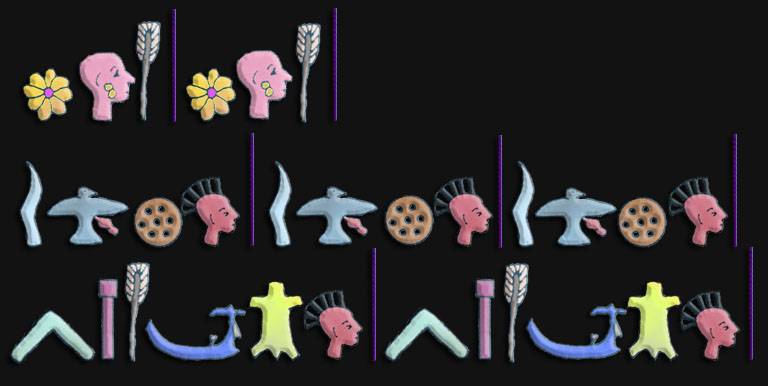
"Narrative art is art that tells a story, either as a moment in an ongoing story or as a sequence of events unfolding over time. Some of the earliest evidence of human art suggests that people told stories with pictures. However, without some knowledge of the story being told it is very hard to read ancient pictures because they are not organized in a systematic way like words on a page, but rather can unfold in many different directions at once." (Wikipedia - "Narrative Art")
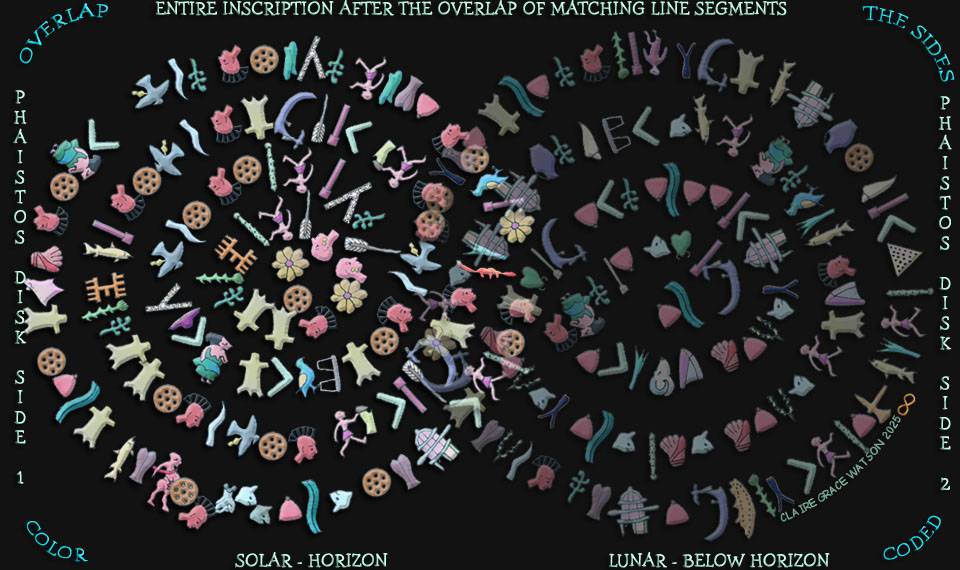 |
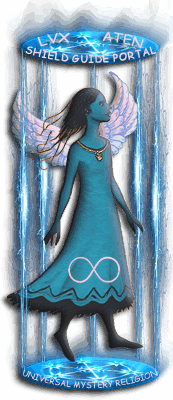 Copyright Notice - Disk of the World - Text and images copyrighted March 21, 1993-2025, Claire Grace Watson, B.A., M.S.T., U.S. Copyright and under the Digital Millennium Copyright Act of 1998, All rights reserved. No part of this web page may be reproduced or transmitted in any form or by any means without written permission from the author, except for the inclusion of brief quotations in a review.
Copyright Notice - Disk of the World - Text and images copyrighted March 21, 1993-2025, Claire Grace Watson, B.A., M.S.T., U.S. Copyright and under the Digital Millennium Copyright Act of 1998, All rights reserved. No part of this web page may be reproduced or transmitted in any form or by any means without written permission from the author, except for the inclusion of brief quotations in a review.